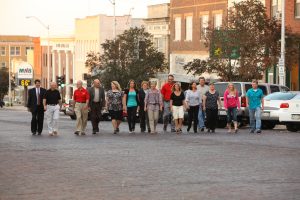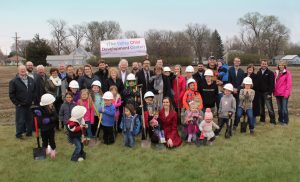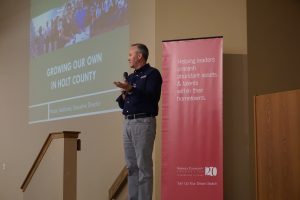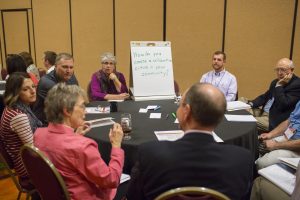Making rural hometowns viable for the next generation: the Nebraska Community Foundation shows how
16 Jan 2018
Millions of people all over the world move from the communities where they grew up to other cities or even countries, in search of better economic prospects or opportunities. This has been the trend in Nebraska, where young people in particular are tending to move to urban centres outside of the state. In fact, this has become such a pattern that a tradition has emerged of giving high school seniors luggage as graduation gifts – “your future is someplace else” being the underlying message.
In response to this trend, the Nebraska Community Foundation (NCF)[1] has built an inter-generational commitment that has not only led to a transfer of wealth back to rural areas, but which has allowed these places to stay strong and dynamic. With a focus on empowering community leadership, building non-profit capacity and investing in local philanthropy aimed at creating greater opportunity and prosperity, NCF has demonstrated the importance of “building community assets that deepen and rekindle people’s belief in the future of their hometowns.”
Jeff Yost, President and CEO of NCF
Jeff Yost, President and CEO of the foundation since 2003, spoke with the GFCF about how NCF has encouraged new generations to be more committed to their hometowns, and touches on why it’s so important that communities lead decision-making processes around the types of investments and development that they’d like to see take place. For further background on NCF’s work, listen to Jeff Yost’s Ted Talk and a 2015 GFCF webinar on the topic of community funds.
GFCF: What are some of the specific actions NCF is taking to change the narrative that “your future is someplace else”?
Jeff Yost: A few years ago, NCF surveyed 6,000 Nebraska middle and high school students about their perceptions of their hometowns. Only 12% said their town is too small to return to, while the majority picture themselves living there in the future if job opportunities are available. That’s great news, but even so, young Nebraskans are constantly being told that the only way to succeed is to leave. I know – I was one of them.
At NCF, we’re focused on making our hometowns places of optimism that attract talent. Places with stories that propose a bright future. Places where everyone – especially young people – feel they have chosen an honourable path. We’re constantly experimenting with new ways and channels to reinforce this message, and storytelling has been central to this effort. Recently, we partnered with two widely distributed Nebraska newspapers to share some of the good news happening across the NCF network, and especially, stories of young people who have chosen the path to return home and make a real difference in their hometowns.
Positive narrative is a critical ingredient to the work we do, and we can see that’s it’s making a real difference in the way people talk about the places they live. Most importantly, these stories are generating more hopeful conversations about the future with youth and young adults.
GFCF: How do you do to reach out to young, talented individuals and keep them connected to their home and strengthen that sense of community?
JY: In the 21st century economy, with technology and the Internet, people can live and work almost anywhere they want. Therefore, the community economic development question is no longer one of jobs. It’s “why here?” Why do I want to live, work and raise my family in this community?
NCF works with hundreds of communities across the state that are trying to answer that very question and attract young people to their hometowns. Like I said, it’s not just about jobs. Young families are looking for stellar childcare and early childhood development opportunities, great schools, entrepreneurship and small business development, and quality of life improvements like access to the arts. Small communities have the capacity to offer all of these things, but it requires collective vision, distributed leadership, engaged citizens and of course, some discretionary capital.
Groundbreaking of the Valley Child Development Center in Red Cloud
GFCF: You talk about the importance of trust within and between your communities. In addition to NCF’s Affiliated Funds, which devolve power, does the community foundation have any other explicit strategies for building trust with communities across such a wide geographic area?
JY: We don’t claim to be experts on anything. People are wary of folks who claim to be experts – and they probably should be! Instead, we’ve spent years cultivating a robust peer mentor network that leverages the experiences and expertise of folks who have been there and are eager to share their knowledge with others. NCF serves as the connective tissue that brings these people together, and Affiliated Fund leaders tell us constantly that access to these peer mentors is one of the most valuable aspects of being part of the NCF network.
NCF’s peer mentor network consists of 1,500 community volunteers
GFCF: What kinds of partnerships are key to the foundation’s vision to build “magnetic hometowns?” Do you have any tips for how to manage and sustain them?
JY: NCF runs on community partnerships. We work with community, organizational and donor-advised Affiliated Funds serving 250 communities located in 80 of Nebraska’s 93 counties. Our statewide network consists of 1,500 community volunteers representing communities as small as 83 and as large as 24,000 citizens. We work directly with these volunteers to support their efforts to build magnetic hometowns and create the hometowns of their dreams.
As far as tips go – not really. There’s no magic bullet solution. It’s hard work! The hardest part of this work in fact, but it’s also the most rewarding. Though I may add that successful partnerships require co-creation and a sense of shared ownership…at least in my experience.
GFCF: Nebraska is large rural state, with many small communities, so how has the structure and the governance of NCF been designed to reflect this and #ShiftThePower closer to the ground?
JY: Strong, progressive communities can only be built and sustained by the people who live and work there. Anyone coming to a town to help should do that and only that. Help.
We like to say that NCF isn’t your typical community foundation – and it’s true! NCF itself doesn’t make grants. We leave that up to community-based affiliated funds at the local level to decide what their own needs and priorities are.
McCook Community Affiliated Fund works across southwest Nebraska
GFCF: How does the Foundation balance ideas of economies of scale / aggregating voice by having a state-wide entity vs. sharing / building power at the community level? This is important for global audiences who would like to learn more about different kinds of structures that can a) build and amplify voice and b) reach people where they are?
JY: At the end of the day, we are all NCF and we are all working toward a shared goal: to build a greater Nebraska for future generations. While we encourage all of our community-based Affiliated Funds to develop their own unique identities (including a mission, vision and values statement), we balance that with the notion that the whole is greater than the sum of its parts. We’re all in this together and if Nebraskans want to create an economically vibrant and attractive place for all of its citizens to live and work, we need strong and progressive communities located throughout the state.
Watch Jeff Yost’s TedTalk on building magnetic hometowns
[1] NCF was established in 1993 to build communities of engaged individuals, who wanted to create prosperous places where people want to live, raise families, do business, work and enjoy the good life. Since its inception, NCF and its affiliated funds have reinvested $263.8 million in Nebraska’s people and places, and has $117.7 million in total assets with $70.9 million in permanent endowments under management.





